CHRNS MACS - The Multi-Axis Crystal Spectrometer

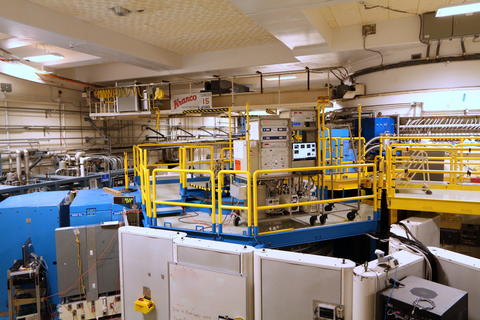
The Multi-Axis Crystal Spectrometer at the NIST Center for Neutron Research is a third generation cold neutron spectrometer that provides ultra high sensitivity access to dynamic correlations in condensed matter on length scales from 0.1 nm to 50 nm and energy scales from 2.35 meV to 16 meV. The project is funded jointly by the NIST Center for Neutron Research, the National Science Foundation, and the Johns Hopkins University.
Specifications/Capabilities
The Multi-Axis Crystal Spectrometer takes advantage of the large solid angle view of the cold source to deliver a high intensity neutron beam at sample position. The large doubly focusing PG monochromator can deliver up to 5x108 neutrons/cm2/s in a 2 cm x 4 cm area at sample position, providing one of the highest neutron beam in the world. Between the monochromator and the sample there is a focusing super-mirror guide that enhances the flux on sample by approximately 20%. Upstream of the monochromator there is a variable beam aperture that controls the overall angular distribution of neutrons that is incident on the sample. There are also radial collimators that control the energy resolution. It is a remarkable aspect of MACS that the Q and E resolution can be controlled virtually independently through these remote controlled devices. The detection system for MACS consists of twenty independent monochromatic channels with variable final energy. There is also an energy integrating detector in each channel. These channels operate simultaneously and in doing so provide 0.15 Sr monochromatic detection plus 0.15 Sr diffraction detection. This is more than an order of magnitude gain in detection efficiency for surveys as compared to a conventional TAS.
Actual MACS configuration:
Incident energy: 2.3 to 17 mev
Energy resolution: 0.05 to 1.4 meV (FWHM)
Monochromator: Doubly focusing PG002
Analyzer: 20 analyzers vertically focusing PG(002) providing 0.15 Sr of detection. Cooled Be, BeO and HOPG filterss and 90' collimators before the analyzers.
Detector: 40 He detectors (20 spectroscopic and 20 diffraction detectors)
Flux at sample: 5x108 neutrons/cm2-s at 12meV open collimator
Scientific Opportunities/Applications
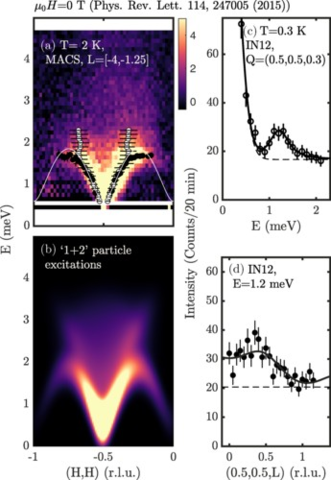
Credit:
D. J. Brener
| Development of a new theoretical framework to model the local magnetic anisotropy of materials Anisotropy in strongly correlated materials plays a key role in determining their electronic ground state and is controlled by the local crystalline electric field. In this study, we develop a method to understand the local magnetic anisotropy and apply it to neutron spectroscopy experiments on the antiferromagnetic CeRhIn₅ (with a Néel temperature of 3.8 K), which shares the same crystal structure as the superconducting CeCoIn₅ (with a critical temperature of 2.3 K). By solving the local crystal field Hamiltonian with a tetragonal symmetry (𝐶₄ point group) and coupling the results to the random phase approximation, we identify two distinct excitation modes, polarized along the crystallographic 𝑐-axis and the 𝑎−𝑏 plane, in agreement with experimental observations. These modes’ anisotropy and energy scale are tunable with a magnetic field, allowing us to distinguish between single and multiparticle excitations. This helps demonstrate the instability of excitations polarized within the 𝑎−𝑏 plane in CeRhIn₅. We also compare our findings to simpler models using effective spin-½ parameters and argue for extending traditional SU(2) magnetic excitation theories to account for the complex nature of the crystal-field states constrained by the 𝐶₄ symmetry.. Details |
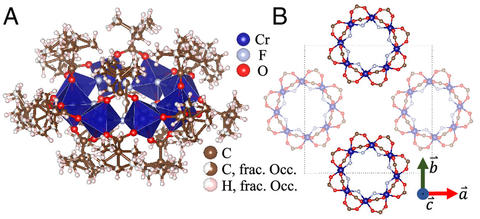
Credit:
Tim Reeder
| Introducing an experimental technique of time-resolved inelastic neutron scattering (TRINS) Spectroscopy—the measurement of the energy-resolved rate of radiation-induced transitions between quantum states of atoms molecules, or electrons in solids—provides unique quantitative information about interactions and dynamical processes. With sensitivity to the anisotropic spatial character of excitations at the atomic scale, inelastic neutron scattering is the principal spectroscopic tool for magnetism. Here, we demonstrate an extension of this technique to probe time-dependent nonequilibrium dynamics in magnetic materials in the time domain beyond μ10 μs. We employ time-resolved inelastic neutron scattering to probe the evolution of a nonthermal state of a singlet ground state molecular magnet induced by pulsed microwaves tuned to resonance between its lowest-lying excited states. Details |
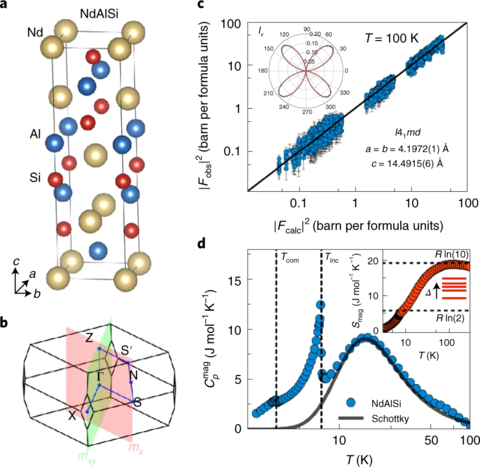
Credit:
Jonathan Gaudet
| Weyl-mediated helical magnetism in NdAlSi Emergent relativistic quasiparticles in Weyl semimetals are the source of exotic electronic properties such as surface Fermi arcs, the anomalous Hall effect and negative magnetoresistance, all observed in real materials. Whereas these phenomena highlight the effect of Weyl fermions on the electronic transport properties, less is known about what collective phenomena they may support. Here, we report a Weyl semimetal, NdAlSi, that offers an example. Using neutron diffraction, we found a long-wavelength helical magnetic order in NdAlSi, the periodicity of which is linked to the nesting vector between two topologically non-trivial Fermi pockets, which we characterize using density functional theory and quantum oscillation measurements. We further show the chiral transverse component of the spin structure is promoted by bond-oriented Dzyaloshinskii–Moriya interactions associated with Weyl exchange processes. Our work provides a rare example of Weyl fermions driving collective magnetism. Details |
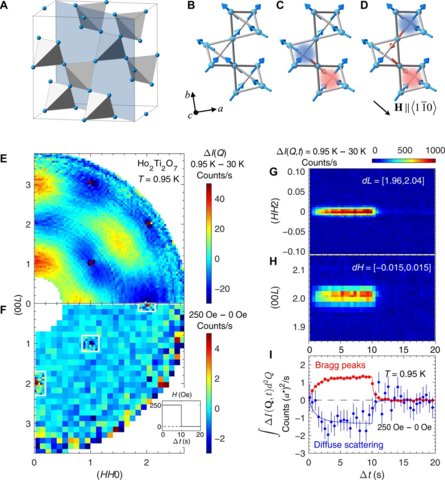
Credit:
Yishu Wang
| Time-resolved elastic neutron scattering is employed to investigate monopolar and dipolar relaxation processes in the spin ice material Ho₂Ti₂O₇. Ferromagnetically interacting Ising spins on the pyrochlore lattice of corner-sharing tetrahedra form a highly degenerate manifold of low-energy states. A spin flip relative to this “spin-ice” manifold can fractionalize into two oppositely charged magnetic monopoles with effective Coulomb interactions. To understand this process, we have probed the low-temperature magnetic response of spin ice to time-varying magnetic fields through stroboscopic neutron scattering and SQUID magnetometry on a new class of ultrapure Ho2Ti2O7 crystals. Details |
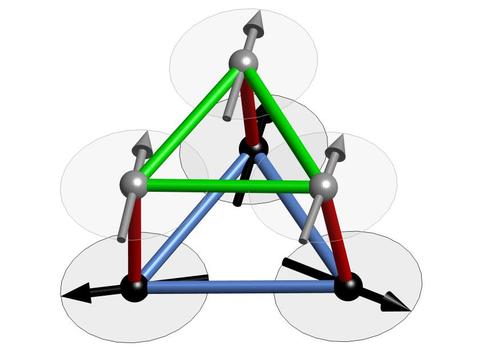
Credit:
Christian Balz/Nature Physics
| Novel State of Matter: Observation of a Quantum Spin Liquid A novel and rare state of matter known as a quantum spin liquid has been empirically demonstrated in a monocrystal of the compound calcium-chromium oxide by team at HZB. What is remarkable about this discovery is that according to conventional understanding, a quantum spin liquid should not be possible in this material. A theoretical explanation for these observations has now also been developed. This work deepens our knowledge of condensed matter and might also be important for future developments in quantum information. The results have just been published in Nature Physics. Details |

Credit:
Nakatsuji / Science
| NIST Contributes to Discovery of Novel Quantum Spin-Liquid An international team of researchers including scientists from the National Institute of Standards and Technology (NIST) has found what may be the first known example of a "spin-orbital liquid," a substance in a never-before-seen quantum mechanical state. Details. |
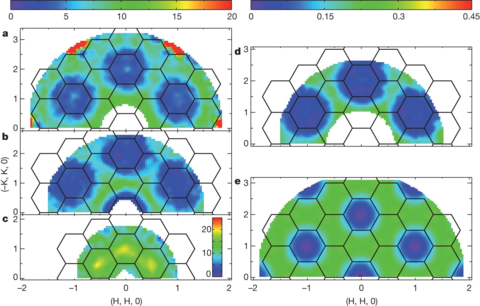
Credit:
Tian-Heng Han / Nature
| For Newly Discovered 'Quantum Spin Liquid', the Beauty Is in Its Simplicity. A research team including scientists from the National Institute of Standards and Technology (NIST) has confirmed long-standing suspicions among physicists that electrons in a crystalline structure called a kagome (kah-go-may) lattice can form a "spin liquid," a novel quantum state of matter in which the electrons' magnetic orientation remains in a constant state of change. Details. |
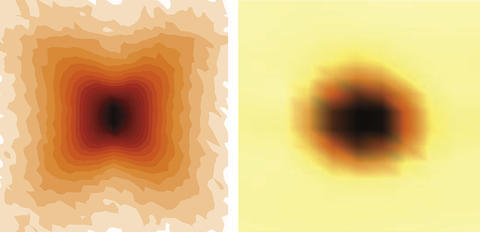
Credit:
Daniel Phelan / PNAS
| Neutron scattering experiments clarify mechanism of piezoelectricity in PMN. Piezoelectrics—materials that can change mechanical stress to electricity and back again—are everywhere in modern life. Computer hard drives. Loud speakers. Medical ultrasound. Sonar. Though piezoelectrics are a widely used technology, there are major gaps in our understanding of how they work. Now researchers at the National Institute of Standards and Technology (NIST) and Canada's Simon Fraser University believe they've learned why one of the main classes of these materials, known as relaxors, behaves in distinctly different ways from the rest and exhibit the largest piezoelectric effect. And the discovery comes in the shape of a butterfly. . Details. |

